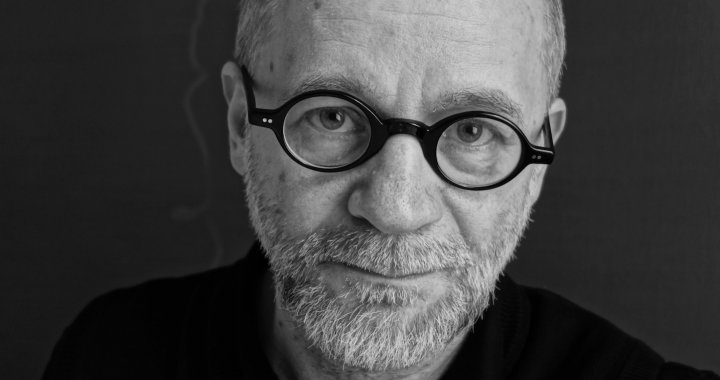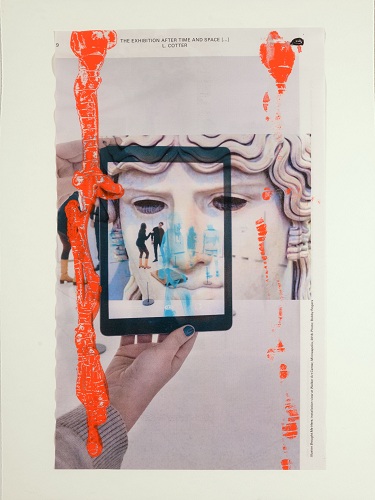
All about melancholia
Interview with Hungarian painter Tamás Soós
28/05/2019
Through 17 June, “Māksla XO” gallery is presenting for the first time a solo show by Hungarian classic painter Tamás Soós in which he continues to develop his metaphysical approach. The exhibition Melancholia focuses on a very important phenomenon in Soós’ creative work – in this case, melancholy is not an individual psychological state but a universal philosophical and existential category that becomes relevant when one becomes aware of one’s mortality. Our conversation on all-encompassing melancholia and the inevitable end, but also on the need for celebrating life (as well as celebrating it in art), took place on a day when the exhibition was being set up.

Photo Renārs Derrings
You call yourself a metaphysicist. What is it about that subject that interests you?
Art itself is metaphysical, not the artist or person. If someone calls their art metaphysical, that doesn’t mean that they are a good artist, but if their art is metaphysical, they are a good artist even if the don’t say so themselves. Art is always metaphysical because humans have come up with the idea that something must be placed between themselves and death. Art helps us to live because it obscures the inevitable knowledge of life being short.
Why is melancholia the best word to describe this state of being?
Behind the metaphysical stands melancholia – it is a stronger and older term. Melancholia is in all people; it helps one live because it is constantly reminding us that life will end. Melancholia stands on the edge of what you feel when standing in front of your parents’ grave, or when watching your brothers and sisters being born.
Is melancholia linked to loss?
No; it is cognizance. Cognizance is joy, and melancholia is also joy. But there can also be pain, of course.
Yet melancholia can also be an apathy-filled, non-creative state.
This is a misconception. The essence of deeper understanding is that all daily activities that people are constantly doing are futile. That is why humanity invented mythology. For example, Greek mythology is a symbolic, charming, rich and enjoyable invention that obscures this awareness of futility. The different faces of melancholy appear in mythological figures. All of culture is meant to place something between humans and their last moment – death. When melancholy intensifies, art becomes more powerful. In speaking about the present, we are awaiting the impact of climate change. In the very near future, there will come a time when we will no longer be able to travel by plane. It's not an intelligent way of thinking – to fly to Florida just to sunbathe and burning huge amounts of fuel in doing so. Thousands of plant and animal species have gone extinct in just a few years. Fairly quickly will we arrive at the moment in which there will be no more drinking water, and it will be so hot that we will not be able to go outside. The coastlines will sink, and the areas on Earth still suitable for living will dwindle. Because of these processes, melancholia grows in strength and shows us that death is very close.
It is not a given that consciousness and human existence are compatible. Perhaps humans will no longer exist, but consciousness will remain. The point of art, and also of this exhibition, is to help people understand this melancholia and to invite them to enjoy life at this time. Symbols of melancholia are generated in the paintings, and the volumes of work indicate how prevalent melancholia currently is – sometimes showing its dramatic side, sometimes its playful side. The paintings depict various options. Also, if a person has been given the opportunity to do something in their life, to show their potential in a certain field, then they should give it their all. Humans are actually lonely; having family and friends is just an existence game. At life’s most important moments, a person is always alone. And that is when we come to face melancholia. Melancholia must be thought of as an energy that is always present. It moves all bodily aspects. Melancholia stands in the middle between consciousness without form and bodily existence. Melancholia is the pain that these two forms of existence are divided. Formless consciousness always thinks the same thing, and this then reiterates within us. And its most complete form is art.

Photo Renārs Derrings
Can we also talk about melancholia as an artist's psychological state?
For me, it is an art term, not a psychological one. Everyone becomes an artist slowly, step by step. And there comes a moment when you finally understand why you are an artist. Melancholia is the source from which my art feeds. Another aspect I use in this exhibition – newspaper and magazine clippings – are reactions to everyday life. In this way, everyday life encounters the essence of art and mythology...as does my art with art made by artists before me.
Which philosophers have influenced the creation of your art system? An influence of ideas stemming from existentialists, such as Martin Heidegger, can be sensed.
Yes, of course, Heidegger too. Humanity has many forms of thinking – philosophy, like art, is one of these. The difference is only in the visual form that art creates. A painting must give the viewer energy, knowledge, strength, and help in living. If that doesn't happen, it's just a decoration.
It raises the question about the stability of this system.
This system itself is an art object; my art is conceptual. And art objects of various styles find their place within it. When we organise an exhibition, either the curator or the gallerist and I create a common concept of what it will look like in the end. When it comes to my sculptures, they resemble those of ancient cultures. Because they are archaic, the melancholia can be better sensed; that’s because in the past, death was considered more natural. Nowadays, people no longer come into contact with death – loved ones die in hospital without the presence of family; death has become mechanised. It is difficult for a person to understand their existence if they do not understand their end. That is precisely why the power of art is also weakening.

Tamás Soós, Mousse News II. 2018-2019
Do you think melancholia is rare in today’s contemporary art?
There is melancholia in every good work of art. For example, at the Lithuanian pavilion at this year's Venice Biennale: people are sunbathing, they feel good, but at the same time, they can feel the approaching heat. This work reflects melancholia to the fullest degree.
I recently spoke to the artist, theorist, and Russian cosmism researcher Anton Vidokle about how he uses slow living and social responsibility as one of the forms of modern human approaches to accepting the inevitability of death.
Exactly. It’s worth thinking about whether you should be drinking wine from Venezuela considering the resources spent shipping it over here. Is it worth going on holiday to distant lands? Perhaps your holiday should be spent right here, at the local lake... Do you really need a plastic bag in which to put the three tomatoes you’re buying in the shop? But visitors to the exhibition do not have to know this. The word 'melancholia' makes it clear enough that it will not be a fun and pretty show. The message is that you have to look carefully at things and delve deeper. Because good art generates within the viewer – the spiritual work of the viewer is needed. My job is to create art that makes people stop at least for a moment, to make sure that the painting is focused upon for a while.
In this sense, time also becomes a subject of the artwork.
Exactly. And the better the art, the more time the viewer needs. That’s why the exhibition will be laid out in such a way that the large-scale works will emit energy and power, but the smaller-sized paintings will require more time to look into them more closely.

Photo Renārs Derrings
Please tell me more about how you select the media for your art.
Sculptures are irreplaceable because they represent and give form to melancholia. Once could say that melancholia is like a hand with fingers that reaches into a person and creates form within them. Optimally, these sculptures would be made from smoke, but that’s very hard to do.
Your paintings on newspapers, for their part, remind one of the presence of melancholia in daily life.
Yes. Other paintings also include daily life, mythology, and even works of other artists, since all artists work on the joint assignment of aiding people in their quest to live. Art is not a story about who is more famous. For example, in ancient times the building of cathedrals was a joint effort, and even nowadays every artist is, in the end, building a cathedral. Art is a building that is constantly creating new structures on melancholia. If it’s the Christian faith that is being juxtaposed against melancholia, then a cathedral is built. If it’s death that is being made the main contrasting factor, then pyramids are built. But if it’s order that you want to place between yourself and death, Bauhaus is created. Nowadays, shopping is one of the levels that is used to stifle the subject of death. And as a result, less and less time is left for reading, enjoying art, or thinking about what one thinks of, for example, when viewing this exhibition. Not always is thinking the most important thing; the main thing is the impression that such a painting gives the viewer. Ilze [Ilze Žeivate, the director of "Māksla XO" gallery – ed.] has created a wonderful space in which, upon entering, you can enjoy good paintings – and that is metaphysical time, after all. In this silence there is achieved a conflict between the metaphysical space and the daily grind that remains outside. I make exhibitions in places where I can achieve that feeling. And this is a good place!
.jpg)